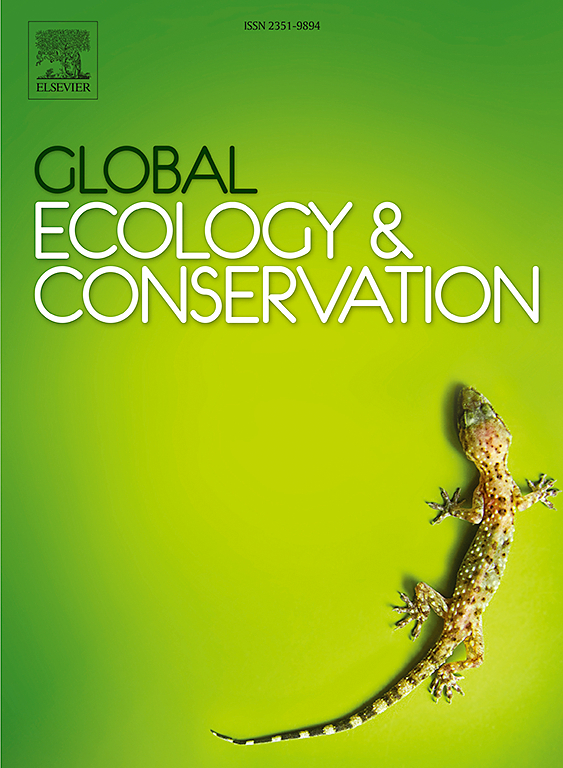African wild dog population status in the Selous-Nyerere landscape, southern Tanzania: Insights from camera trap surveys
IF 3.5
2区 环境科学与生态学
Q1 BIODIVERSITY CONSERVATION
引用次数: 0
Abstract
Despite being one of the world’s most endangered carnivore, there is a deficiency of recent information on the status of African wild dog (Lycaon pictus) in some of the few landscapes where viable populations are thought to still occur. One example is the Selous-Nyerere landscape in southern Tanzania, a critical stronghold for the species that has not been studied since the 1990s. We use data from seven camera trap surveys deployed over 4674 km2 in Selous Game Reserve (GR) and Nyerere National Park (NP) from 2020 to 2022 to provide an update on wild dog status in the landscape. We identified a total of 222 wild dogs, of which 38 % were male, 38 % were female, and 24 % were of unknown sex. We applied spatially explicit capture-recapture (SECR) modelling to the data from 2565 km2 of Selous GR to estimate an over-dispersion adjusted population density of 2.14 ± 0.45 adult and yearling wild dogs per 100 km2 (95 % confidence interval: 1.42 – 3.21). This study demonstrates the ways in which camera trap data can be used to improve our understanding of wild dog populations in data-limited settings, but also highlights some limitations of this data type for the species. Our findings suggest that the Selous-Niassa ecosystem is one of the most important remaining populations of wild dogs in Africa. Although this study did not directly investigate mortality, we recommend long-term monitoring and a number of conservation actions to tackle the species’ apparent threats in the landscape, and help secure this stronghold into the future.
坦桑尼亚南部塞卢斯-尼雷尔地区非洲野狗种群状况:来自相机陷阱调查的见解
尽管非洲野狗(Lycaon pictus)是世界上最濒危的食肉动物之一,但在一些被认为仍有存活种群的少数景观中,有关非洲野狗(Lycaon pictus)状况的最新信息缺乏。一个例子是坦桑尼亚南部的塞卢斯-尼雷尔(Selous-Nyerere)景观,这是自20世纪90年代以来就没有研究过的物种的重要据点。我们使用了从2020年到2022年在塞卢斯野生动物保护区(GR)和尼雷尔国家公园(NP)部署的4674 平方公里的7个相机陷阱调查的数据,以提供野狗在景观中的最新状况。共鉴定出222只野狗,其中雄性38% %,雌性38% %,性别未知24% %。我们将空间显式捕获-再捕获(SECR)模型应用于Selous GR 2565 km2的数据,估计每100 km2的过度分散调整种群密度为2.14 ± 0.45只成年和一岁野狗(95 %置信区间:1.42 - 3.21)。这项研究表明,在数据有限的情况下,相机陷阱数据可以用来提高我们对野狗种群的理解,但也强调了这种数据类型对该物种的一些局限性。我们的研究结果表明,Selous-Niassa生态系统是非洲现存最重要的野狗种群之一。虽然这项研究没有直接调查死亡率,但我们建议长期监测和采取一些保护行动,以解决该物种对景观的明显威胁,并帮助确保这个据点的未来。
本文章由计算机程序翻译,如有差异,请以英文原文为准。
求助全文
约1分钟内获得全文
求助全文
来源期刊

Global Ecology and Conservation
Agricultural and Biological Sciences-Ecology, Evolution, Behavior and Systematics
CiteScore
8.10
自引率
5.00%
发文量
346
审稿时长
83 days
期刊介绍:
Global Ecology and Conservation is a peer-reviewed, open-access journal covering all sub-disciplines of ecological and conservation science: from theory to practice, from molecules to ecosystems, from regional to global. The fields covered include: organismal, population, community, and ecosystem ecology; physiological, evolutionary, and behavioral ecology; and conservation science.
 求助内容:
求助内容: 应助结果提醒方式:
应助结果提醒方式:


